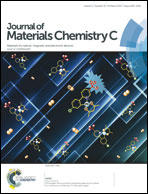Directed self-assembly of rhombic carbon nanotube nanomesh films for transparent and stretchable electrodes†
Abstract
The development of a transparent and stretchable electrode is critical to the realization of stretchable optoelectronic devices. In this study, a template-guided self-assembly is demonstrated for the integration of carbon nanotubes into 2D rhombic nanomesh films, where the deformation of the rhombic structure accommodates the strain, greatly improving the stretchability. In addition, the regular 2D nanomesh patterns greatly reduce the contact resistance and light scattering. Our rhombic carbon nanotube nanomesh films exhibited significantly lower sheet resistance (∼10 times) at a similar optical transmittance (78%), greater stretchability (∼8 times less resistance increase at 30% strain), and better mechanical durability (∼42 times less resistance increase after 500 stretching cycles at a strain of 30%) than those of random-network carbon nanotube films.


 Please wait while we load your content...
Please wait while we load your content...